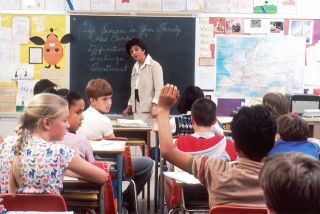Education
The Deeper Agenda Behind Social Emotional Learning
SEL programs train children for autonomy. But they shouldn't be unquestioned.
Updated June 21, 2024 Reviewed by Tyler Woods
Key points
- Abigail Shrier rightly takes issue with SEL, a growing program in schools, but not in a helpful way.
- A careful critique must begin with trying to understand what real needs the program seeks to address.
- I offer an interpretation of its appeal. SEL is not so much a training for sociability as for autonomy.
The subtitle of Abigail Shrier’s bestselling Bad Therapy is a more helpful guide to the book’s contents than its title: Why the Kids Aren’t Growing Up. The book is not mainly about “therapy,” at least in the sense of psychotherapy and its developments. When Shrier speaks of those who engage in bad therapy, she is referring to a wide assortment of people, including parents and others who are not mental health professionals.

Bad Therapy is about what social critics since Philip Rieff have called the “therapeutic.” Rieff first took the word from the domain of professional specialization and used it to describe the growing psychologization of society. The therapeutic as a cultural ethic, Rieff argued in his Triumph of the Therapeutic (1966), is a language for the management of self and interpersonal relations. In this ethic, the self is characterized both by its power to actualize itself and by its vulnerability to victimization and such internal “pathologies” as low self-esteem.
Shrier’s concern is with the spread of the therapeutic ethic, especially with how it has entered the educational system (the “epicenter of bad therapy”) from the primary grades on up. She is right to recognize this as an important development that needs to be challenged. But her way of doing so is not helpful.
Take Shrier’s discussion of social emotional learning (SEL). She does not provide any sense of its purpose or the real problems to which it is addressed. Rather, she criticizes teachers, school psychologists, and guidance counselors for “playing shrink.” These “enthusiasts” and “true believers,” she charges, are unwittingly subjecting kids to an ethically compromised and antitherapeutic program of trauma talk and emotional navel-gazing. The program is a hazardous exercise in “useless meddling.”
There is more to it than that. If we want to mount an effective critique of SEL, we need to begin by asking what might make it convincing or inspiring.
Social Emotional Learning
First, a little background.
Social emotional learning (SEL) is on the curriculum throughout the U.S. educational system (and other countries as well). According to a 2021 nationally representative survey of teachers and principals conducted by the Collaborative for Academic, Social, and Emotional Learning (CASEL) and the Rand Corporation, “76 percent of principals and 53 percent of teachers reported use of either a commercially produced or a district- or school-produced [SEL] curriculum (or both) to a ‘moderate’ or ‘great’ extent.” When you add in those who reported using an “SEL approach” rather than a formal program to promote students’ SEL, the numbers grow another 15 to 20 percent.1
According to CASEL, which produces one of the most widely used frameworks, SEL is made up of five interrelated areas of competence:
- Self-awareness: The ability to identify and recognize one’s own emotions and thoughts and understand how they impact behavior.
- Social awareness: Having empathy and respect for others and the ability to take on different perspectives.
- Responsible decision-making: The ability to make ethical, constructive choices about personal behavior and social interactions.
- Self-management: Being able to manage one’s emotions and impulses, manage stress, and set personal goals.
- Relationship skills: Having the capacity to establish and maintain healthy, supportive relationships.2
The framework, CASEL and others stress, is “evidence-based” and proven by research to promote “academic performance, healthy relationships, mental wellness, and more.” Much of this training may take place at home, and SEL programs send materials home and may be tiered according to the different needs of students. SEL is both the subject of explicit instruction and is to be reinforced in every class and throughout the whole school culture.
Why these specific “skills”? And why should we see them as essential subjects for school instruction?
Training for Autonomy
Let me propose an answer. Somewhat paradoxically, the cultivation of such skills is less training for sociability than it is training for autonomy.
We think of autonomy as the independence to make our own decisions, without interference. It is that, but it is also our condition.3 As we all know, our society and our institutions have changed profoundly over the past half-century, growing ever more complex and differentiated. Many of the old rules and restrictions have disappeared, along with the cultural guidance and authority of social roles and customs. Perhaps less obvious is how our situation creates new responsibilities and makes new demands on us. We must now produce from our own resources much that used to be given.
Work is a good example. From most places of employment, the old job protections and guarantees have largely been eliminated. We cannot count on job security or stability. To succeed or even “remain relevant,” we must be flexible, proactive, and self-confident. We need the ability and resources to develop new skills and the nimbleness to know when. Much work now, especially in the white-collar world, also requires a wide range of soft skills: emotional intelligence, an easy affability, a collaborative attitude, a creative mindset, and a knack for impression management.
Other domains of life require similar self-awareness and abilities. To carry ourselves as an individual, we have to create our own projects, build supportive networks, adapt to frequent change, and project a future. We have to conduct our interpersonal relations with sensitivity to difference, recognition of others’ points of view, and the skill to defuse conflict and control our emotions. The list of such personalized norms is long.
Like never before, we need key personal qualities to make our way in the world. Not being born with them, we must acquire them. In fact, some argue that social inequality is now less a question of class conflict than “a question of the unequal distribution of the personal qualities that make it possible to develop autonomy.”4
SEL as Answer
With such demands of autonomy in mind, reread the list of SEL competencies. See the connection? Yes, SEL is addressed in part to students’ bad conduct and academic struggles. But the bigger target, I suggest, and why SEL is offered to all students and sent home to parents, is to equip them for autonomy in a world of flux. And that training, that promise, is what makes it so appealing to many educators and parents.
Professionals regard this investment as crucial precisely because this is the very time in young lives when the agency required for autonomy can be developed or stunted, when inequality can be reduced or reproduced. Perhaps this is also why, as others have documented, professionals can be so touchy about it. The good they are seeking to cultivate in young people seems so unquestionably indispensable.
Yet, there are good reasons to question such a pedagogical program. Social engineering by schools has often proved to be counterproductive, and programs that serve the internal institutional needs of schools for docile behavior and academic motivation seem unlikely to build student agency for the world outside it.
Further, though treated as learnable developmental “skills,” many of the competencies are clearly values, beliefs, and dispositions. Specific lessons include things like learning to “identify and label your feelings”—hardly a neutral exercise. There is an ethic here, a system of normative principles and standards that is being conveyed but not acknowledged as such. This lack of transparency is indefensible.
SEL is not “useless meddling.” It is an influential program that aims to address real needs. But it is also not above critique. Teasing out what makes it appealing is the place to start.
References
1. Heather L. Schwartz, et al. “Social and Emotional Learning in Schools Nationally and in the Collaborating Districts Initiative: Selected Findings from the American Teacher Panel and American School Leader Panel Surveys.” CASEL and Rand Corporation, 2022. https://casel.org/sel-in-schools-nationally-and-in-the-cdi/?view=true#:~:text=Seventy%2Dsix%20percent%20of%20principals,the%202021–2022%20school%20year
2. Jessica Souza, “What Is Social and Emotional Learning? How SEL Programs Help Kids Succeed in School.” https://childmind.org/article/what-is-social-and-emotional-learning/
3. This idea is central to the work of the French sociologist Alain Ehrenberg. For a good overview, see John Marks, “Alain Ehrenberg: Autonomy and Empowerment,” French Cultural Studies 33 (2022): 105-117.
4. Ibid, p. 113.




